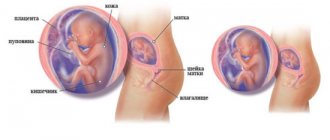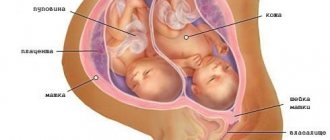Interesting Facts
| Options | Indications |
| Time from conception | 23 weeks |
| Period by month | 25 weeks |
| What month | 6 |
| Dimensions and weight of the fetus | 330 mm, 660 g |
| Uterus dimensions | 1-2 cm above the navel, VDM 22-25 cm |
| Pregnant weight | Gain from the beginning of pregnancy is 5-8 kg; over the last week no more than 400-500 g |
Your baby is the size of
A small pumpkin
330mm Size
660 g Weight
The size of the uterus at 25 weeks of pregnancy is comparable to a football. You begin to walk like a pregnant woman, and it takes some effort to sit and lie down comfortably. The baby continues to actively gain weight and every day he trains to breathe, swallow and control his movements. What else happens to the mother and unborn child at this stage? Let's find out, but first let's decide on the calculations.
Possible problems
Pain at the 25th obstetric week of pregnancy
A woman may experience pain from time to time from the moment she conceives a child. The 25th week of pregnancy is no exception. It is very important not to endure or wait out the pain, because this can lead to miscarriage. It is better to seek medical help to solve the problem and understand its cause than to put it off and then bite yourself.
Pain can occur in the abdomen, lower back, anus, sacrum, legs, and head. To exclude this, you must:
- exercise;
- wear comfortable shoes without heels;
- do not sit with your legs crossed, do not lie on your back;
- do not stay in a vertical position for a long time;
- proper rest;
- wear a bandage belt and compression garments.
Fever and colds
It’s easy to catch a cold during pregnancy, because a woman’s immunity is weakened during this period. Anyone with a viral infection can become a source of infection. The expectant mother should ensure that treatment is started as soon as possible and a doctor must be involved in this. Only he can prescribe drugs and methods that will not harm the child.
There is no need to lower the temperature to within 37.5 degrees. In the second and third trimester, it is possible that it may rise to this level, especially in the late afternoon, and this is considered normal. It is necessary to control the temperature, because extreme heat can negatively affect the baby’s health. Compresses, rubbing with cool water, and drinking plenty of fluids will help alleviate the condition. Cough, runny nose and sore throat should be treated with herbal infusions and inhalations. In severe cases, the doctor will prescribe medications that will not cause much harm to the fetus.
To avoid getting sick during epidemics, you should adhere to the following recommendations:
- Avoid hypothermia of the body, especially the legs and lower back.
- Do not visit public places. But if there is an urgent need, use a mask.
- Ventilate the room more often.
- Use safe ointments to prevent colds. You can also use traditional medicine. Black radish juice is especially effective.
Discharge at 25 weeks of pregnancy
A woman at 25 weeks should be alert to any changes in discharge. Normally, they should be whitish in color and have a uniform consistency without a pungent odor. If you find something different on your underwear, consult a doctor immediately. During this period, amniotic fluid may leak, which has a yellowish tint. An examination by a doctor should help identify the cause. Leakage is dangerous for the life of the fetus, so the woman is hospitalized and treated in a hospital.
A curdled discharge with a sour smell is thrush. Having discovered them, it is necessary to obtain a doctor’s prescription and begin treatment as quickly as possible.
The infection does not pose a mortal danger to the child, but in advanced forms it can seriously affect his health.
Feelings of the expectant mother
The growing uterus and abdomen cause discomfort. Burning sensation and heartburn are frequent companions of a pregnant woman. The urge to urinate increases, congestion, swelling, and varicose veins occur.
Due to increased fatigue or pressure changes, a pregnant woman experiences headaches. After standing or walking for a long time, the lower back inevitably starts to pull. Take care of yourself, be sure to take a break from work. Ideally, you can lie down in the middle of the day for 15-20 minutes.
Emotionally, a pregnant woman at 25 weeks feels serene and comfortable. This is facilitated by both an even hormonal background and a nascent connection with the unborn child. Mom feels when the baby moves. Sometimes you can see the baby’s kicks on the surface of the abdomen. He responds to stroking and your voice. This is an amazing miracle that gives a woman the strength to endure all the hardships of pregnancy.
Changes in the body of the expectant mother
Since conception, so many changes have occurred in a woman’s body that this affects her appearance, as well as the functioning of all systems. What changes can be noted at this stage of pregnancy?
Belly at 25 weeks of pregnancy
The pregnant woman's belly is noticeably rounded, moreover, even under clothes it is already very noticeable. It is growing quickly now, so the skin is stretching. Unfortunately, not all women manage to avoid the appearance of stretch marks, which arise due to the fact that the skin does not have time to stretch quickly. To prevent this phenomenon, it is recommended to use special gels and creams that increase the elasticity of the dermis. If stretch marks do occur, these remedies will not help remove them. However, there is a positive point - after childbirth, the stretch marks will become lighter, and over time they will be less noticeable.
There is an interesting comparison: the size of the uterus at this stage of pregnancy is the same as the size of a football. This visual image allows you to imagine the conditions in which a baby grows up.
Many mothers want to see changes happening to them. Therefore, if you want to capture in your memory how your belly has changed at 25 weeks of pregnancy, a photo of your belly will help you do this.
Breasts at 25 weeks of pregnancy
From the beginning of pregnancy, changes occur not only in the abdomen, but also in the mammary glands of the expectant mother. They “tune in” to future feeding, and therefore increase in size and produce colostrum, which will be used to feed the baby in the first days after birth. Already now, a woman may notice that droplets of colostrum protrude from the breasts from time to time. Therefore, it is important to carefully monitor hygiene and wear a bra made of natural fabric.
25 weeks of pregnancy, weight gain, normal
It is completely normal for a woman to gain weight during pregnancy. But this needs to be monitored closely. Monitoring changes in the expectant mother's weight allows us to assess her condition. Normally, by week 25, weight gain is about 6.5 kg. The appearance of excess weight can be influenced by poor nutrition or swelling. When a gynecologist notices the appearance of excess weight in a pregnant woman, he checks for the presence of edema. To do this, press your finger on the skin of the shin above the bone. If a “dent” has formed that does not disappear within a few seconds, we can say that there is swelling. If it is not detected, the woman is usually recommended to adjust her diet.
Movements at 25 weeks of pregnancy
The closer to birth, the more noticeable the baby’s movements become. And it’s not always just movements. Now a woman can describe them as thrusts. And this is natural, because the baby becomes cramped in the space that surrounds him. While the baby is in a comfortable position, he can push off with his arms and legs several times. And if something scares him, then such a “kick” is his defensive reaction.
Many pregnant women note that the tremors become more painful with each passing week. To calm the baby, sometimes it is necessary to change position or lie down, because he may push because he is uncomfortable. In some cases, the baby calms down when the mother begins to stroke her tummy and hum. Each woman finds her own ways to calm the baby, because right now their emotional connection is very strong.
Doctors recommend paying attention to the nature of the child’s movements. The fetus at the 25th week of pregnancy is quite active, but it still has sleep breaks. If a pregnant woman feels that the activity of movements has noticeably decreased (they are absent for 12 hours) or, on the contrary, has increased, she needs to inform the doctor about this, because such behavior of the baby may indicate that he is not feeling well.
Discharge at 25 weeks of pregnancy
The appearance of discharge during pregnancy should not alarm a woman. Paying attention to the nature of the discharge, it can be noted that it is almost transparent or has a white tint, is practically odorless, and is homogeneous in consistency. However, there are signs that should alert a woman if they appear:
- Color change. Green, gray, brown discharge indicates the presence of some pathologies in the pregnant woman’s body.
- Change in smell. This sign, like the change in color, is alarming.
- A change in consistency also speaks in favor of pathological changes. For example, white cheesy discharge indicates the presence of thrush, which must be treated so that the baby does not become infected with this disease when passing through the birth canal.
- Bloody issues. Sometimes they appear after examination by a gynecologist if minor damage to the mucous membrane has occurred. But in most cases they can be, for example, a sign of microdetachment or placenta previa. Therefore, this phenomenon cannot be ignored under any circumstances. If blood appears, you should immediately consult a doctor.
- Transparent watery discharge. We need to talk about them separately. If a woman notices that she has to change the pad several times during the day, then this may be a cause for concern, since this is how amniotic fluid leaks.
No matter how the nature of the discharge changes, the pregnant woman in any case needs to discuss this with the gynecologist who is managing her pregnancy.
Nausea at 25 weeks of pregnancy
During a normal pregnancy, women should not experience nausea, since toxicosis should have already passed. But sometimes nausea appears even at this stage of pregnancy. With what it can be connected? Sometimes, in the later stages, women begin to experience gestosis - a condition characterized by the occurrence of edema, increased blood pressure and convulsions. Sometimes it occurs earlier. This can affect the baby’s health, so it is important for a woman to closely monitor changes in health.
Temperature at 25 weeks of pregnancy
A slight increase in body temperature during pregnancy is not dangerous. Sometimes women notice that the temperature rises from time to time to 37 degrees. If it is high and lasts for some time, and to this are also added symptoms characteristic of a cold, you should consult a doctor so that he can prescribe the appropriate treatment.
Childbirth at 25 weeks of pregnancy
Despite the fact that the birth is still far away, premature birth at 25 weeks of pregnancy can still occur. This can happen if there were some risks that led to early labor.
Unfortunately, the baby’s development is not yet the same as that of a child born at term. His respiratory system is not yet fully functional, his immune system is too weak, and there is very little subcutaneous fat to carry out thermoregulation. However, in our country there are centers in which modern equipment is installed and all the necessary drugs are available to doctors. Therefore, babies born at this stage have a fairly high chance of survival.
What does a baby look like at 25 weeks of pregnancy?
He looks more and more like a newborn: the body proportions are correct, facial features have taken shape, the amount of subcutaneous fat is increasing, but the skin is not as transparent as it was a couple of weeks ago. Tiny capillaries appear, giving it a pinkish tint.
The average weight of the fetus is 660 grams, height is 33 cm. It still has enough space in the uterus to actively move. He taps the walls of the uterus, grabs the umbilical cord and his legs with his hands, turns and somersaults.
The child is already reacting to your mood. Are you irritated or angry? The baby is worried along with you and shows this with active movements.
How internal organs develop
- The structure of the brain becomes more complex: auxiliary cells of nervous tissue appear; synapses are formed - nerve connections; the grooves separating the hemispheres become deeper.
- The lungs produce surfactant, which ensures that the alveoli open during the baby's first breath after birth.
How does the fetus develop?
At week 28, the baby in the womb reaches a size of 34.5 cm and weighs approximately 0.7 kg. He already looks like a little man. The lungs are still underdeveloped. The body does not release surfactant, which prevents the alveoli from sticking together in the lungs, from the inhaled air.
Before this stage of pregnancy, hematopoiesis occurred mostly in the liver and spleen, but now it occurs more in the bone marrow. At this stage of intrauterine development, the baby has already developed a sense of smell, he senses the mother’s mood, can frown or smile and feels pain.
The baby in the stomach is actively moving and pushing with arms and legs. His movements are coordinated. Bones and muscles continue to grow. The genital organs will already be visible on the ultrasound, as they are formed. And you will finally find out the gender of your baby.
Tests and ultrasound
No special studies are carried out during this period, only if there are special indications. Normally, a pregnant woman comes for examination twice a month, having passed a general urine test the day before. The gynecologist notes on the chart the weight, abdominal circumference, and where the fundus of the uterus is located relative to the navel. Measures blood pressure and gives general recommendations to prevent complications.
An ultrasound examination is not prescribed as part of standard pregnancy management at week 25. But if the doctor has doubts about the condition of the fetus, additional examination is carried out. During it, the specialist evaluates the amount of amniotic fluid, the thickness and location of the placenta, the size of the fetus and its heartbeat.
What happens to the uterus of a pregnant woman at this time?
At this stage, the size of the uterus resembles a soccer ball. Its bottom is 25-27 cm above the pubic bone. If deviations from this norm are detected, the pregnant woman is sent for examination. If the fundus is insufficient, placental insufficiency or fetal growth retardation may occur. In some cases, a woman feels contractions of the uterus, which thus prepares for childbirth. But if these contractions are accompanied by severe pain, you need to call an ambulance.
Possible complications
The twenty-fifth week of pregnancy usually passes relatively calmly and serenely from the point of view of the mother's health. But it is important to know the alarming symptoms of pathologies in order to consult a specialist in time.
Early cervical dilatation
It manifests itself as bloody vaginal discharge and severe pain in the lower third of the abdomen and perineum. If detected early, it can be successfully treated with sutures or a pessary.
Gestosis in the second trimester of pregnancy
Accompanied by severe swelling and increased blood pressure. Emergency hospitalization and symptomatic treatment are required.
Polyhydramnios
This diagnosis is made on the basis of ultrasound, which assesses the amount of amniotic fluid. The following signs indirectly indicate the disease:
- difficulty breathing, a woman may literally not have enough air;
- weakness and fatigue even from minor exertion;
- a feeling as if the stomach is turning to stone and rough stretch marks of the skin on it;
- swelling.
This is a dangerous condition for both mother and fetus. In 30% of cases, without medical assistance it leads to the death of the child. Fortunately, serious acute polyhydramnios is extremely rare, while moderate polyhydramnios – on the border of the physiological norm – occurs in every 10 patients and can be successfully treated.
Ultrasound at 25 weeks
An ultrasound evaluates the baby's spine . You can already find out for sure who lives inside - a boy or a girl . An error is possible in extremely rare cases, which is due to the inconvenient position for research. During the ultrasound, you are told that the baby weighs approximately 630 g and is 32 cm tall.
The amount of amniotic fluid is assessed . When polyhydramnios or oligohydramnios are detected, a thorough comprehensive assessment of the fetus over time is required to exclude developmental defects, signs of intrauterine infection, etc. necessary measurements are also taken .
For clarity, we present to you the normal range:
- BPR (biparietal size) - 58-70mm.
- FZ (fronto-occipital size) - 73-89mm.
- OG (fetal head circumference) - 214-250 mm.
- Coolant (fetal abdominal circumference) - 183 -229 mm.
Normal sizes of fetal long bones:
- Femur 42-50 mm
- Humerus 39-47 mm
- Forearm bones 33-41 mm
- Shin bones 38-46 mm
Tips for choosing a bandage
A device for supporting an enlarged belly will reduce the load on the spine. This is especially important if the pregnancy is multiple, there is a scar on the uterus, as well as if the cervix is underdeveloped and there is a threat of miscarriage. Even if you are not in the risk group, but spend a lot of time on your feet, the bandage will reduce the feeling of fatigue and reduce discomfort in the lower back.
There are 3 types of bandages: in the form of panties, a corset and a belt. We recommend that you pay attention to the last one - an elastic belt that you can use during pregnancy and after childbirth, simply turning it over to the other side.
When choosing a size, focus on your hip circumference, but make allowances for the fact that it may increase a little more before the end of pregnancy. The most convenient way is to try on the bandage before purchasing, wrapping it under your stomach. However, remember that it is correct to put on the belt only in a lying position.
Recommendations and advice for the expectant mother
- Don't overuse salt;
- Make sure that your legs are slightly higher than the rest of your body when you sleep, for example, place pillows under your calves;
- Wear compression stockings or tights (they do a great job of relieving discomfort);
- Avoid constantly being in one position (sitting, standing), try to warm up every 10-15 minutes;
- Do Kegel exercises. They will help keep the pelvic muscles in perfect order, prepare the perineum for childbirth, and will be a good preventative against the appearance of hemorrhoids (your doctor will tell you how to do them);
- Start preparing your breasts for feeding your baby (take air baths, wash your breasts with cool water, wipe your nipples with a rough towel). WARNING: Do not overdo it, breast stimulation can cause premature labor;
- To avoid swelling, consume liquids no later than 20 minutes before meals; do not eat after 20.00 hours; limit your salt intake; cook cranberry or lemon juice, which has an excellent diuretic effect;
- Sleep at least 9 hours a day;
- Start shopping for a bandage;
- Spend as much time as possible in the fresh air, as oxygen is useful for strengthening the body of the baby and mother;
- Arrange a family photo session with your husband. When will you ever be as beautiful as you are now?
Previous: Week 24 Next: Week 26
Choose any other one in the pregnancy calendar.
Calculate the exact date of birth in our service.
How did you feel at the 25th obstetric week? Share with us!
Checklist for 25 weeks of pregnancy
- To help yourself with insomnia, take a walk before bed, drink tea with mint or motherwort. Lie on your left side with a pillow between your knees.
- Monitor your weight gain: normally, you can gain up to 500 grams weekly. Larger numbers and sharp changes are an alarming sign that requires consultation with a specialist.
- Discuss with your employer the details of your maternity leave: there are only 5 weeks left until it, and if you have a multiple pregnancy, then 3.
Entrust your pregnancy management to the specialists of the Medical Women's Center. We offer you various types of laboratory tests and ultrasound, the ability to choose a doctor and involve other specialists according to indications, an individual observation plan and assistance in selecting a maternity hospital.










